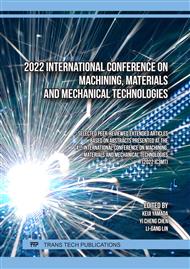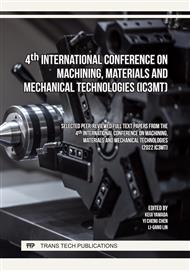p.11
p.19
p.25
p.33
p.41
p.51
p.59
p.69
p.77
Numerical Investigation of Bearing Characteristics of a Hydrostatic Thrust Bearing with a Flow-Control Restrictor Using a Bending Beam
Abstract:
In general, high-precision machines, such as machine tools and measuring equipment, have employed moving tables with hydrostatic bearings. Hydrostatic bearings for these high-precision applications require high bearing stiffness and response speed. Various flow-control restrictors inserted in oil passages were proposed to improve bearing characteristics. However, the active control of conventional flow-control restrictors has some shortcomings because most flow-control restrictors employ voice coil motors (VCMs), which generally consume a large amount of electricity and raise the oil temperature. The increased oil temperature decreases the oil viscosity, which reduces bearing stiffness and damping. Although piezo actuators can solve the above problems and are suitable candidate alternatives to VCMs, their small range of travel has prevented their use in flow-control restrictors. In this paper, a novel flow-control restrictor using a bending beam in stroke expansion is proposed for the purpose of employing piezo actuators. In addition, the bearing characteristics of the hydrostatic bearing with the proposed flow-control restrictor were investigated numerically. In this investigation, the Rayleigh-Ritz method for solving the deformation equations of the bending beam and the divergence formulation method to obtain the pressure distribution in the hydrostatic bearing were adopted in the numerical calculations. The results showed that the hydrostatic thrust bearing with the proposed restrictor has higher stiffness compared with conventional hydrostatic bearings using a capillary restrictor.
Info:
Periodical:
Pages:
41-49
Citation:
Online since:
February 2024
Authors:
Price:
Сopyright:
© 2024 Trans Tech Publications Ltd. All Rights Reserved
Share:
Citation:



